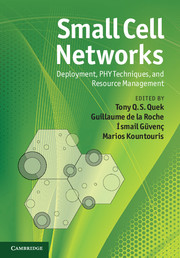Book contents
- Frontmatter
- Contents
- List of contributors
- Foreword by David Chambers
- Acknowledgments
- Acronyms
- 1 Small cell networks overview
- 2 Fundamentals of access control in femtocells
- 3 Coverage analysis using the Poisson point process model
- 4 Interference modeling for cognitive femtocells
- 5 Multiple antenna techniques in small cell networks
- 6 Physical layer techniques for cognitive femtocells
- 7 Femtocell coverage optimization
- 8 Random matrix methods for cooperation in small cell networks
- 9 Mobility in small cell networks
- 10 Cognitive radio resource management in autonomous femtocell networks
- 11 Decentralized reinforcement learning techniques for interference management in heterogeneous networks
- 12 Resource allocation optimization in heterogeneous wireless networks
- 13 New strategies for femto-macro cellular interference control
- 14 Femtocell interference control in standardization
- 15 Spectrum assignment and fairness in femtocell networks
- 16 Self-organization and interference avoidance for LTE femtocells
- Index
- References
2 - Fundamentals of access control in femtocells
Published online by Cambridge University Press: 05 May 2013
- Frontmatter
- Contents
- List of contributors
- Foreword by David Chambers
- Acknowledgments
- Acronyms
- 1 Small cell networks overview
- 2 Fundamentals of access control in femtocells
- 3 Coverage analysis using the Poisson point process model
- 4 Interference modeling for cognitive femtocells
- 5 Multiple antenna techniques in small cell networks
- 6 Physical layer techniques for cognitive femtocells
- 7 Femtocell coverage optimization
- 8 Random matrix methods for cooperation in small cell networks
- 9 Mobility in small cell networks
- 10 Cognitive radio resource management in autonomous femtocell networks
- 11 Decentralized reinforcement learning techniques for interference management in heterogeneous networks
- 12 Resource allocation optimization in heterogeneous wireless networks
- 13 New strategies for femto-macro cellular interference control
- 14 Femtocell interference control in standardization
- 15 Spectrum assignment and fairness in femtocell networks
- 16 Self-organization and interference avoidance for LTE femtocells
- Index
- References
Summary
Access control in femtocell deployments
One unique trait of femtocells is that they are paid, installed, and managed by the end users. Compared with macrocells, which are installed by the network operators and thus can be accessed by any user, femtocells can choose the set of users that is allowed for access. In the simplest scenario, the femtocell can be configured for either: (i) closed access, where only registered home users can use the femtocell; or (ii) open access where any nearby users are allowed to use the femtocell. The choice of femtocell access control involves many important issues in two-tier femtocell networks [1-6].
The first important issue is cross-tier interference. Unlike wireless fidelity (WiFi) access points, femtocells serve users in licensed spectrum to guarantee quality of service (QoS) and because the devices they communicate with are developed for those frequencies. Compared to allocating separate channels inside the licensed spectrum exclusively to femtocells, sharing spectrum would be preferred from an operator perspective [1, 5, 7]. However, the co-channel spectrum sharing between femtocells and macrocells potentially gives rise to serious cross-tier interference in closed access. As shown in Figures 2.1 and 2.2, in closed access a cellular user, even when it is geographically close to a femtocell, is forced to communicate with the distant macro base station (BS). Therefore, this cellular user suffers from strong downlink interference from the nearby femtocell (see Figure 2.1), and likewise causes strong uplink interference to that femtocell (see Figure 2.2) [8-10].
Information
- Type
- Chapter
- Information
- Small Cell NetworksDeployment, PHY Techniques, and Resource Management, pp. 13 - 43Publisher: Cambridge University PressPrint publication year: 2013
